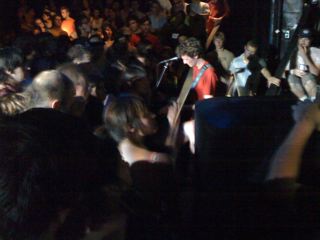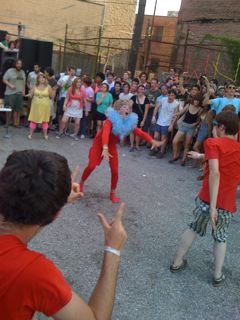By Gene McHugh

Scratch the surface of Baltimore, an American city best known for high homicide rates and crab cakes, and you might get a whiff of the schizo, silly perversion that camp auteur John Waters famously captured in celluloid. A case in point is the music festival Whartscape, the Wham City art collective's freak-power counterpoint to the city of Baltimore's annual crafts 'n corndogs festival, Artscape.
In this, the festival's third year of operation, Whartscape has adopted a wider angle lens, expanding the lineup to 77 bands, playing over 4 days and nights, in legally secured venues. This expansion of the festival can most likely be seen as a result of the "Baltimore's got a cool scene" meme that has spread as far into the mainstream as Rolling Stone Magazine who declared that, indeed, Baltimore does the have the "Best Scene" (of 2008, anyway). Given the hype, it might seem tempting to enter into this "scene" with a skeptical eye, however, this year's Whartscape still felt like a somewhat unexploited, cozy family affair.

Videohippos
To give an example of how things basically go down: Baltimore singer and performer Lizz King impromptu danced while donning a shabby tiger mask during the Creepers set; the Creepers are a Baltimore band featuring Adam Endres from the Baltimore band Blood Baby and Blood Baby also features Kevin O'Meara from the Baltimore band Videohippos; the other member of the Creepers is Connor Kizer who is in the Baltimore band Santa Dads with Joshua Kelberman who's the brother of Baltimore comic artist Dina Kelberman, who worked at a Baltimore movie theatre with Victoria from the Baltimore band Beach House and went to college with, respectively, Dan Deacon and the visual artist Jimmy Joe Roche.

Joshua Kelberman from Santa Dads
According to Dina Kelberman, a reason why things seem to be continuing at a healthy clip in the Charm City is the cross-disciplinarity of the people involved. The walls between art/technology/music/doodling/parties/performance/whatever simply breakdown. The artists Mark Brown and Kari Altmann, for instance, have their own art practices, but they also work as a DJ/VJ team at the warehouse parties that define so much of what happens in Baltimore's underground.
Of all the events at the festival, Dan Deacon's set at Whartscape was perhaps the strongest because of his ability to motivate the crowd. Deacon seems to have expanded his interests outside of music per se and, instead, toward what a friend of mine (quoting the artist Michael Portnoy) likes to call "Relational Stalinism." According to Mark Brown, "Dan's been getting really into crowd control. That's his new thing...by starting every show with a bizarro round of 'Simon says,' Dan does an amazing job of getting everyone in the audience under his control." Deacon will usually begin his set by instructing the crowd to take their hand, make a fist, point their finger to their favorite cloud, make eye contact with strangers, rub their hands on each other's faces, etc. Then he will launch into the music while commanding the audience to run around in a big circle, go into a "gauntlet," and enter an epic circles versus triangles dance showdown. This might sound like a trite display of community bonding or a megalomaniacal overreach on the part of Deacon, but somehow it maintains a sense of sincerity and fun. Whereas projects falling under the relational aesthetics umbrella of the 1990's may have been critiqued for a certain overdetermination and paradoxical elitism, Deacon's yoga class/dance-party/elementary-school-recess takes advantage of the momentary energy generated by the crowd by amplifying its communal core. As Deacon said at a point mid-way through his set, "Let's make that big circle again. The circles are maybe - no definitely - more successful and important than the song playing."
Gene McHugh is Rhizome's Editorial Fellow

